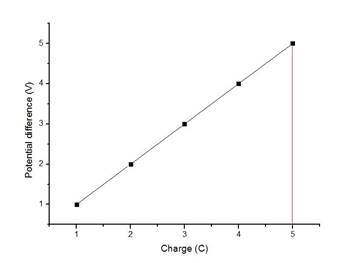
Concept explainers
To plot: a graph of
To find: the voltage across the capacitor.
To find: the energy in joule.
To explain: whether the energy equal to the total charge times the final potential difference or not.
Answer to Problem 101A
The required graph is shown. The voltage across the capacitor is 5.0 V. energy stored in a capacitor is 12.5 J and it is half of the product of charge and potential value.
Explanation of Solution
Given:
The value of the capacitor is
Charge to be added is
Formula used:
The energy needed to increase the potential difference of a charge
The expression for potential difference can be expressed as
Calculation:
The potential difference in a capacitor is equal to the ratio of charge and the capacitance of the capacitor that is,
Here,
Substitute the values of
Therefore, the potential difference in a supercap is 5.0 V.
Below table shows the data of the charge and the voltage:
| Charge (C) | Potential difference (V) |
| 1.0 | 1.0 |
| 2.0 | 2.0 |
| 3.0 | 3.0 |
| 4.0 | 4.0 |
| 5.0 | 5.0 |
The graph between charge and the potential difference is shown in the following figure. Here, the charge is taken along the

The area under the curve is equal to the energy stored in the capacitor. Hence, the area under the curve is equal to the area of the triangle.
From the above graph, the base of the triangle is 5.0 C and the height of the triangle is 5.0 V.
Substitute the values of base and height in the equation in the equation of the area of the triangle formula,
Rounding off to two significant figures, the energy stored in a capacitor is 13 J.
The total energy stored in a capacitor is not equal to the charge times the final potential difference.
The product of the charge and final potential difference is,
This value is approximately half of the energy stored in a capacitor. So, each charge could require the same amount of maximum charge to place it on the capacitor.
Conclusion:
Hence, the required graph is shown. The voltage across the capacitor is 5.0 V. Energy stored in a capacitor is 12.5 J and it is half of the product of charge and potential value.
Chapter 22 Solutions
Glencoe Physics: Principles and Problems, Student Edition
Additional Science Textbook Solutions
Genetic Analysis: An Integrated Approach (3rd Edition)
Human Anatomy & Physiology (2nd Edition)
Cosmic Perspective Fundamentals
Chemistry: The Central Science (14th Edition)
Organic Chemistry (8th Edition)
Applications and Investigations in Earth Science (9th Edition)
- Hi! I need help with these calculations for part i and part k for a physics Diffraction Lab. We used a slit width 0.4 mm to measure our pattern.arrow_forwardExamine the data and % error values in Data Table 3 where the angular displacement of the simple pendulum decreased but the mass of the pendulum bob and the length of the pendulum remained constant. Describe whether or not your data shows that the period of the pendulum depends on the angular displacement of the pendulum bob, to within a reasonable percent error.arrow_forwardIn addition to the anyalysis of the graph, show mathematically that the slope of that line is 2π/√g . Using the slope of your line calculate the value of g and compare it to 9.8.arrow_forward
- An object is placed 24.1 cm to the left of a diverging lens (f = -6.51 cm). A concave mirror (f= 14.8 cm) is placed 30.2 cm to the right of the lens to form an image of the first image formed by the lens. Find the final image distance, measured relative to the mirror. (b) Is the final image real or virtual? (c) Is the final image upright or inverted with respect to the original object?arrow_forwardConcept Simulation 26.4 provides the option of exploring the ray diagram that applies to this problem. The distance between an object and its image formed by a diverging lens is 5.90 cm. The focal length of the lens is -2.60 cm. Find (a) the image distance and (b) the object distance.arrow_forwardPls help ASAParrow_forward
 College PhysicsPhysicsISBN:9781305952300Author:Raymond A. Serway, Chris VuillePublisher:Cengage Learning
College PhysicsPhysicsISBN:9781305952300Author:Raymond A. Serway, Chris VuillePublisher:Cengage Learning University Physics (14th Edition)PhysicsISBN:9780133969290Author:Hugh D. Young, Roger A. FreedmanPublisher:PEARSON
University Physics (14th Edition)PhysicsISBN:9780133969290Author:Hugh D. Young, Roger A. FreedmanPublisher:PEARSON Introduction To Quantum MechanicsPhysicsISBN:9781107189638Author:Griffiths, David J., Schroeter, Darrell F.Publisher:Cambridge University Press
Introduction To Quantum MechanicsPhysicsISBN:9781107189638Author:Griffiths, David J., Schroeter, Darrell F.Publisher:Cambridge University Press Physics for Scientists and EngineersPhysicsISBN:9781337553278Author:Raymond A. Serway, John W. JewettPublisher:Cengage Learning
Physics for Scientists and EngineersPhysicsISBN:9781337553278Author:Raymond A. Serway, John W. JewettPublisher:Cengage Learning Lecture- Tutorials for Introductory AstronomyPhysicsISBN:9780321820464Author:Edward E. Prather, Tim P. Slater, Jeff P. Adams, Gina BrissendenPublisher:Addison-Wesley
Lecture- Tutorials for Introductory AstronomyPhysicsISBN:9780321820464Author:Edward E. Prather, Tim P. Slater, Jeff P. Adams, Gina BrissendenPublisher:Addison-Wesley College Physics: A Strategic Approach (4th Editio...PhysicsISBN:9780134609034Author:Randall D. Knight (Professor Emeritus), Brian Jones, Stuart FieldPublisher:PEARSON
College Physics: A Strategic Approach (4th Editio...PhysicsISBN:9780134609034Author:Randall D. Knight (Professor Emeritus), Brian Jones, Stuart FieldPublisher:PEARSON





